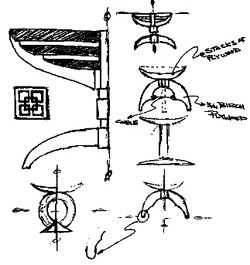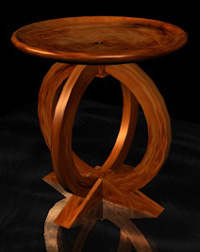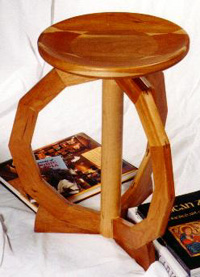|
On Making Furniture…
By Jomo Tariku
So what does it take to design a berCHuma or any other furniture piece? Hmmm?
Well it all starts with an idea and cup of Café Latte. Don’t forget the Latte. It is the juice of creativity. Got to get the buzz, man! First you have to find a place that enhances your mood. If you are a starving designer or artist like me, the best place is Border’s Bookstore and Cafe.
Why? Well, here is the 411 or the 10-10-321:
1. Free coffee after drinking your 10th 16oz. Latte.
2. Browse the books you can’t afford to buy (eat your heart out Kuraz Bookstore).
3. Interesting or annoying crowd, depending at what time of the day you show up.
4. A table that is not level—helps in designing something new as you rock back and forth.
5. Free, weird music sampling.
6. Cheesecake that looks good but might rob you of your coffee money and the loose change you hid in your shoes.
7. A better looking place than your home studio, office, bedroom….
I have made it a habit of visiting bookstores and using them as a resource and a hang out. Books on art, design, architecture and history inspire me to find solutions when I run into a mental block. No need to reinvent the wheel if somebody has already done it. Maybe all I have to do is put a different spin on an idea to create a new piece. So the first thing I do is get the research part out of the way. Then I start sketching.
 For example, to develop a series of contemporary African furniture, I picked the arch and ribbed sections of the Axum Obelisk. Based on these two historical, cultural and architectural themes, I created a sense of continuity in my furniture. While it is sometimes very obvious to see, I occasionally understate the connection to soften the flow. For example, to develop a series of contemporary African furniture, I picked the arch and ribbed sections of the Axum Obelisk. Based on these two historical, cultural and architectural themes, I created a sense of continuity in my furniture. While it is sometimes very obvious to see, I occasionally understate the connection to soften the flow.
After settling on a theme, I sketch about ten quick thumbnails. I refine the thumbnails by tracing over my original work and expanding on my design. Also, I make sure I avoid having a mass produced look. After all, my goal is to create functional art-- furniture that is beautiful and utilitarian at the same time.
The next step in the design process is to convert the two-dimensional concept drawings into a three-dimensional simulation. With the help of a computer-aided design and three-dimensional modeling software, I recreate the furniture. The 3D software enhances my ability to perceive scale, negative and positive space, wood grain and color, joints, ergonomics, and dimension.
 I follow up the 3D modeling process by building a one-fourth-scale model
using foam core, cardboard or thin pieces of wood. This model helps
me evaluate the structural soundness of my design. If there are any
problems, I modify the 3D-computer model, and build the next iteration of
the scale-down model. The process continues until all of the structural
issues are worked out. After dimensioning, I am ready to purchase the lumber. I follow up the 3D modeling process by building a one-fourth-scale model
using foam core, cardboard or thin pieces of wood. This model helps
me evaluate the structural soundness of my design. If there are any
problems, I modify the 3D-computer model, and build the next iteration of
the scale-down model. The process continues until all of the structural
issues are worked out. After dimensioning, I am ready to purchase the lumber.
I always purchase wood in blocks and mill it to the size I want. Buying a block of wood, instead of individually cut small pieces, has an advantage. It is a little bit cheaper and, more importantly, you tend to get consistent grain and wood color since you are cutting from same piece of lumber. With material in hand, I head off into my woodwork shop, to start the part of the process that I enjoy and hate at the same time. Creating quality hand crafted furniture is time consuming. Safety also is a big concern. Actually, on two occasions, while using a lathe machine and a band saw, I gave my projects an unintended crimson stain. This is the only time I follow all of an electrical equipment manufacturer’s warning to the letter.
Building a prototype is not always an easy process. A lot of things can go wrong. It is one thing to be able to draw it but quite different to build it. In addition, certain types of wood can release toxic fumes into the air, splinter when cut against the grain, break during turning, shear when run through the joiner, etc.
 After cutting all of the pieces I sand and glue the pieces. Again gluing a piece presents its own tricky scenario. Depending on the glue I use, I have to put the pieces together quickly before the glue sets. I repeat the sanding process after the glue dries. I sand the surface with a fine grade paper until it is smooth. The last step is picking a surface finish like polyurethane, Danish oil, etc. and applying it. After cutting all of the pieces I sand and glue the pieces. Again gluing a piece presents its own tricky scenario. Depending on the glue I use, I have to put the pieces together quickly before the glue sets. I repeat the sanding process after the glue dries. I sand the surface with a fine grade paper until it is smooth. The last step is picking a surface finish like polyurethane, Danish oil, etc. and applying it.
Finally the piece is ready for a photo shoot and to be displayed on the Net, which starts the critiquing from friends and family. After careful analysis, their suggestions will be incorporated in to my next design. And that, my friends, is how furniture is designed and built.
Jomo Tariku is a freelance artist and designer who specializes in Contemporary African Furniture. For a complete set of his ongoing work, go to www.kc.net/~jomodzn.
A show concentrating on his various Axum styled furniture and contemporary Ethiopian Crosses will be displayed at WorldSpace in Washington, DC on May 6 and 7, 2000.
|